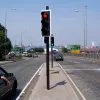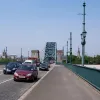Like so many northern towns, in the 1960s Gateshead was suffering a decline in its traditional sources of employment and its cityscape of smoke-stained Victorian buildings was considered outdated. It chose to do what many similar towns did: regenerate, quickly and in concrete.
It built multi-storey car parks, office blocks, council estates; it swept aside streets in favour of tower blocks on open grassy lawns. And, of course, it built the Gateshead Highway, an elevated road that was meant to be the first stage in its contribution to the urban motorway network planned across the whole of Tyneside.
The Highway was the only bit that Gateshead ever really finished, and on its own it never really worked very well. Today, there are plans afoot to sweep it away, open up the space underneath to see the sky, and create a new tree-lined route described as "Gateshead Boulevard" in its place.
Now that the days of this unloved viaduct are numbered, here are some pictures of it taken back in 2006, on an exceptionally sunny day when even a grimy concrete flyover could look its best.
A vision of the future Gateshead once imagined: here is a view looking south from the end of the Highway. Unusually, it rises up as two separate ramps on either side of a dual carriageway. Traffic remaining on a lower level meets a roundabout with the A184; traffic heading up top gets a non-stop rooftop-level journey through to the south end of the town centre.
When the Highway opened it carried the A1, which was planned to run through the centre of both Newcastle and Gateshead. The Highway would have run on to a new crossing of the Tyne, then on to a new motorway running east of the existing Central Motorway in Newcastle. None of that ambitious plan ever happened.
For all that it's disliked, it is particularly well designed. The pedestrian subway here is standard 1960s fare, but up above, the flyover ramps are quite graceful from underneath, with a sloped and textured underside that is angled so that the bulk of the structure is less obvious and oppressive from here. It is supported on very slender columns that maintain the illusion that it's lighter and thinner than it really is.
Without the rest of the motorway network, the Highway dumps all its traffic onto the surface level road leading through the north end of the town centre and on to the Tyne Bridge. There's not enough space for this and now — far from the free-flowing dream envisaged by its creators — traffic coming off the flyover hits this set of traffic lights that control the merge point.
Just north of the end of the Highway is another remnant of the grand road plans that enjoyed a very brief heyday in this part of the world. This stub of redundant road, starting in the middle of the dual carriageway and merging in to southbound traffic on the right-hand sided, looks quite surreal. It would have been part of a different junction arrangement had the road plans been finished off.
Without the motorways, swathes of empty land were left sterilised, and this part of Gateshead has struggled to feel like a town centre. It's one of the problems that the Boulevard plan is trying to solve. This picture shows the line of the Highway's northward continuation: ahead is the glassy shape of the Sage, but in the foreground, there's just low-rise commercial space and open grass verges, more suburban retail park than town centre.
We could hardly come to this part of the world without visiting the Tyne Bridge. Opened in 1928, it's still a spectacular structure today, carrying four narrow lanes of traffic at considerable speed across the river clear of shipping.
It directly connects the Gateshead Highway to the Central Motorway in Newcastle, but — according to the plans under which both those roads were created — should have been bypassed by now with another motorway. Instead it's still here, one of the most critical points on Tyneside's road network.








